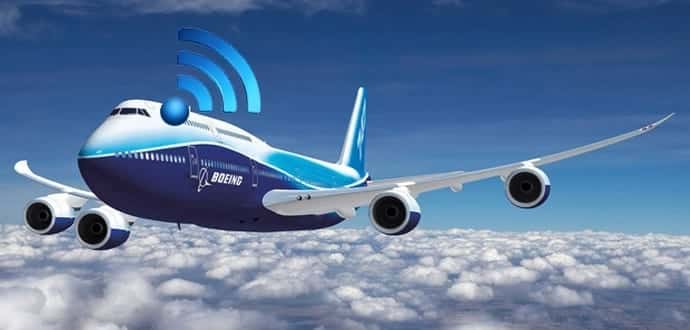How Does Airplane Wi-Fi Work?
Do you know how an airplane Wi-Fi works?
Internet has become an integral part of everyone’s life, as connectivity has become important these days. As a result, the in-flight announcement to switch off our electronic devices or put it on airplane mode while on board can become a hitch if you have to finish last minute presentations, or check e-mails, or surf through social media sites on the go.
In order to make the flight experience a less stressful and an enjoyable one, the first in-flight Wi-Fi services started in 2008 when Virgin America introduced Gogo’s Inflight Wi-Fi facility in its fleet of airplanes. Gogo Inc. is a provider of in-flight broadband Internet service and other connectivity services for commercial and business aircraft, headquartered in Chicago, Illinois.
With the efforts taken by Gogo and the various technologies it adapts to provide in-flight Wi-Fi, has helped a lot of airlines improve their on board services with the growing demand of always being connected. 17 airlines partner with Gogo to provide in-flight Wi-Fi, including British Airways, Aer Lingus, Iberia, Gol linhas aereas, Beijing Capital, Aeromexico, American Airlines, Air Canada, Alaska Airlines, Delta Air Lines, Japan Airlines, JTA, United Airlines, Hainan Airlines, Virgin America, Vietnam Airlines and Virgin Atlantic.
So, how does exactly the Wi-Fi in an airplane work? Basically, there are two primary methods to enable a passenger with Internet connection on an airplane: Air-to-Ground and Satellite.
ATG (Air-To-Ground)
As the name suggests, ATG is the means by which people on the ground and those in airborne vehicles communicate with each other. ATG are similar to cell phone towers albeit much larger and are designed for domestic travel over land. The ground-based mobile broadband towers send signals up to an aircraft’s antennas. An antenna located on the bottom of the plane transmits and receives signals to and from towers on the ground (low-power ground transceivers). As the plane travels into different sections of airspace, the plane automatically connects to signals from the nearest tower, so there is no interruption to your browsing. However, if you are passing over large bodies of water or particularly remote terrain, connectivity can be an issue.
Also, Gogo has rolled out the newest generation system ATG-4 technology that takes advantage of multiple antennas—four of them, arranged strategically along the fuselage—to grab signals and offer faster speeds, whose bandwidth is up to 9.8 megabits per second (Mbps) per airplane (shared across all users), which is enough for email and casual web surfing.
Satellite
Unlike ATG networks, satellite networks can provide the aircraft with connectivity anywhere around the globe – over land or over water. A small satellite antenna located on the top of the plane’s fuselage under a bubble-shaped radome communicates with a satellite in orbit above the earth. That satellite, which maintains an endless connection with a ground station, acts as a bridge to supply the plane with a live link to the Internet. The nearest satellite in orbit supplies the connection to the plane as the plane moves along its defined route.
With the amount of available bandwidth increasing along with the frequency, satellite networks transmit data at different frequency bands. The two common bandwidths used for in-flight connectivity today are L-band and Ku-band. L-band – sometimes referred to as narrowband –
has an operating frequency range of 1–2 GHz in the radio spectrum and has only 30 MHz allocated for use. The L band is one of the chief operating ranges used by various applications such as radars, global positioning systems (GPS), radio, telecommunications and aircraft surveillance. Comparatively, Ku-band networks utilize 500 MHz of frequency bandwidth between 11-14.5 GHz. Both narrowband and broadband networks are capable of providing global satellite coverage.
has an operating frequency range of 1–2 GHz in the radio spectrum and has only 30 MHz allocated for use. The L band is one of the chief operating ranges used by various applications such as radars, global positioning systems (GPS), radio, telecommunications and aircraft surveillance. Comparatively, Ku-band networks utilize 500 MHz of frequency bandwidth between 11-14.5 GHz. Both narrowband and broadband networks are capable of providing global satellite coverage.
With a frequency range of 19-31 GHz and 500 MHz allocated for use, major air carriers are now starting to install cob Ka-band satellite antennas that have to reach hundreds of megabytes per second, enough for streaming even on an occupied plane where many people are trying to connect.
Source: Altitude


![How To Read Deleted WhatsApp Messages? [Working 2019]](https://blogger.googleusercontent.com/img/b/R29vZ2xl/AVvXsEjekX46Bu79o0XT2nwhL6Uj7SDzew-iP1dqXflRQfAwyVLJE7QWkN8LIRUADV4P8Y5fTvj46B074-hlZ9XMdsbxz9HYYG9vgqgFqFSZf62dFHf-_34bhwFHfEy8iUkJIiEYdNyw1iur7eEO/w680/How-To-Read-Deleted-WahtsApp-Messages-696x414.jpg)


0 Comments